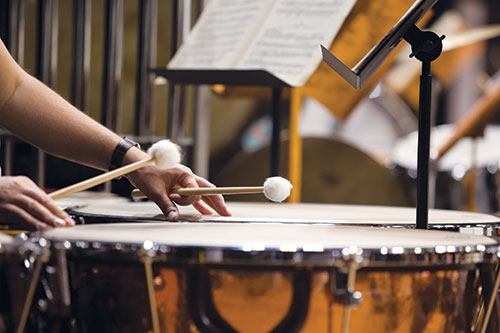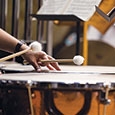All musical sounds consist of a combination of attack, sustain, and decay. Attention to all three components is an important aspect of fine musical phrasing and precise ensemble playing. In the percussion sections of many ensembles, the attacks of notes are given much more attention than the decays. This article recommends several ways to help student percussionists focus their technique on producing effective musical decay on a variety of instruments.

Typically Muffled Instruments
Percussionists frequently muffle instruments such as timpani, bass drum, cymbals, tam-tam, and triangle, but with different techniques for each. This section offers a basic overview of how to muffle each of those instruments and a few finer details for shaping the sound of each.
Timpani
Timpani are so resonant that percussionists rarely allow their sound to decay by itself. Use the flat, fleshy pads of the final joint of all fingers to gently press into the playing spot of the head to stop the sound. For simple passages that can be played with one hand, use only one mallet to free your muffling hand for optimal mobility. For timpani parts that incorporate two, three, or four drums, players must be able to muffle comfortably with either hand and to move the muffling among the drums just as one moves the mallets among the drums. Practice playing with one hand and muffling with the other while moving across the drums in one direction; then reverse the hands and the process. Finally, practice muffling with the hand that just played while alternating back and forth between drums, as shown below. The mallet simply shifts into the space between the thumb and first finger to free the finger pads to muffle and then shifts back out to play.

Consider different types of muffling, depending on the musical passage. Sometimes a strong, firm muffle works fine. In softer, more subtle circumstances, players may need to taper the sound gradually and imperceptibly. Try rolling the pads of the fingers naturally from pinkie to thumb to dismiss the sound lightly. For very loud notes, especially those followed by total silence across the ensemble, players can muffle the same drum with both hands, to increase skin-to-drum contact and distribute it more evenly and efficiently across the vibrating head.
Bass Drum
The bass drum is quite resonant as well, and it requires similar finger pad muffling. Given the size of the head and the fact that many rhythmic passages on bass drum require only one mallet, some players wear a soft mitt or hold a small towel in the muffling hand to extinguish the sound quickly and fully. Unique to the bass drum is that both heads vibrate rather fully, so generally the back head will need to be muffled as well, especially on final notes. To accomplish this, have the player elevate the knee on the playing side of the drum with a commercially available foot rest or some other small stand or instrument case. Muffle the playing head with the knee and the back head with the free hand. If using two mallets for a fast passage or roll, the muffling hand will hold the mallet as described for timpani playing with two mallets.
Cymbals
Cymbals require different muffling techniques depending on whether they are paired or suspended, as well as on the musical context. Paired crash cymbals are usually pulled into the lower chest. After a large isolated crash that descends into a subsequent phrase, players might extinguish the sustain gradually, while a series of sharp offbeat eighth notes might require an immediate inward motion toward the player initiated within the crash itself. Players should practice muffling crash cymbal notes in one continuous motion to be prepared for fast passages. In situations where a player moves directly from a cymbal crash to another instrument, the cymbals can be muffled simply by placing them directly on a soft, covered trap table. This option should only be used when absolutely necessary; otherwise, muffle them with the chest and then place them carefully and quietly on the table.
Suspended cymbals are generally muffled with the hands. Players should practice muffling with either hand after various lengths of unmeasured rolls and isolated notes to develop dexterity in muffling with the mallets still in their hands. As with paired cymbals, suspended cymbals may be muffled sharply and definitively or gradually and subtly, depending on what follows in the music.
Tam-Tam
Perhaps the most important factor in muffling the tam-tam effectively is positioning the body to be able to muffle both the front and back of the disc simultaneously. Tam-tams are large instruments and produce strong vibration patterns. Muffling with both hands, one on each side of the instrument, helps by increasing skin contact with the instrument and prevents the disc from swinging or shifting. For precise cutoffs, players must muffle the tam-tam slightly ahead of the desired silence as the sound will put up a bit of a fight before disappearing completely.
Triangle
Body position is important for successful muffling on triangle as well. Hold the instrument with a grip that allows the fingers to curl comfortably around it and to be ready to muffle subtly but fully. Use a triangle clip with the string loop adjusted so that the instrument can vibrate freely without moving back and forth or side to side excessively. The fingers should be poised to close around the instrument quickly, but not before the triangle sound has flowered on a given note. A common pitfall is to create a dead metallic sound by partially muffling the instrument already while playing it. Timing and precision will produce both a satisfying musical attack and a satisfying musical release.
Muffling Mallet Instruments
The xylophone and marimba generally require no hand muffling; in fact, it should be discouraged on these instruments because natural oil from human hands should be kept away from their expensive wooden bars. The glockenspiel (orchestra bells) and crotales require hand muffling quite frequently. Players should use their fingertips to muffle individual notes or small clusters simultaneously and can use their shirt sleeves horizontally to muffle a large number of notes together. In an ascending line requiring only one hand, the right hand should play and the left hand should trail it, muffling each note just as the next one sounds. The opposite technique works for descending lines. Players can experiment with varying levels of staccato and legato by altering the timing of their muffling in relation to the onset of the next note.
Players should also practice muffling back and forth between hands, similar to timpani. Playing simple melodies from a method book can provide opportunities to practice releases and coordinate muffling into the hand rhythm required to play such passages not only correctly, but also musically. Directors would be wise to treat keyboard muffling with the same intensity as they approach other instruments’ articulations.
Muffling on chimes and vibraphone is typically accomplished with the pedal, but hand muffling (on the chimes) and mallet muffling (on the vibraphone) can be helpful for eliminating certain notes while sustaining others with the pedal. On the chimes, the hand simply closes around the playing spot of the tube, and on the vibraphone the mallet presses gently into the bar to eliminate the sound. In the example below, the player can pedal the entire passage, on either instrument, and simply muffle the G# with the hand (chimes) or mallet (vibraphone) to eliminate the dissonance if desired.

Muffling Other Instruments for a More Precise Sound
Many percussion instruments have a relatively quick natural decay, and percussionists typically do not muffle them. However, some of these instruments, such as snare drum, concert toms, hand drums, and various accessories, can be muffled to great effect, especially for better phrase shaping and for final notes in passages or pieces.
Snare Drum
Many players use some sort of mute (e.g., a small gel square, a wallet, or an ID card) to dry up the sound of the snare drum overall. Although this is convenient, it may change the sound of the drum and reduce its projection. Muffling with the hand can be helpful for shortening specific notes while letting the rest of the passage sound fully. Two situations in which this is useful are just after a sustained roll and during repeated staccato notes, especially offbeats. Muffling just after the final note of a snare drum roll creates a strong contrast between the full sustained sound and no sound at all, rather than a slight taper effect produced by letting the vibrations dissipate naturally. This can be especially effective when a tutti silence follows the roll.
When playing offbeats (or any repetitive staccato notes), muffling helps to shape the notes exactly, creating a rhythmic feel that encompasses both precise attacks and releases. In many cases, muffling will make room for other instruments that may be playing the onbeats. These recommendations may seem unnecessary given the natural quick decay of the snare drum, but bringing a snare drum to your performance space to test these sounds will help you be sure you have the sound exactly as you want it.
Concert Toms
Muffling on concert toms brings similar advantages to muffling on snare drum, with the added factor of multiple surfaces and pitches. Players can create rhythmic and melodic phrasing not only through starting the notes in beautiful and logical ways but also by stopping them precisely. Consider the passage at the top of the next column:

Percussionists could play this part exactly as written and allow the drums’ sounds to decay naturally. However, by muffling the eighth note, they create a meaningful contrast between long and short notes, and help to propel the passage forward with more rhythmic interest. Muffling on a passage like this might also help align the part with other sections of the ensemble. Just as directors would likely spend substantial time helping clarinets or cellos release those notes precisely and musically, they should require percussionists to do the same through muffling. Tom-tom muffling, used in a passage like the one above, might be thought of as a cross between timpani muffling (i.e., around multiple drums) and snare drum muffling (i.e., subtle muffling of select notes as desired for contrast).
Hand Drums
To create lively and precise sounds on hand drums, allow the hands to contact the drumheads loosely to muffle and shape the length of individual notes, especially on the lower, more resonant drums. I recently had the opportunity to play a pattern like this on two low hand drums:

If I had played it as written with no muffling, the lower drum, especially, would have sustained quite a bit. By treating the resonance of that drum like that of timpani, I was able to create a much more effective groove, which was especially important because this was a solo passage in a musical scene change. My hand subtly and naturally descended on the low drum to stifle its sound just as the higher drum entered. The sound of the low drum did not disappear completely, but simply faded into the background dramatically enough to make room for the higher note to speak clearly. This technique created a much more lively sound, which the conductor complimented as “awfully danceable.”
Accessory Instruments
In comparison to the triangle, most other accessory instruments naturally sustain much less. Temple blocks, cowbell, brake drum, and anvil are examples of such instruments that are rarely muffled in standard performance practice. Again here, a final note of a passage after which silence ensues might be the most common situation in which to muffle them. Specific models of each of these instruments differ widely, so players must decide if and when muffling is necessary or desirable. Experiment with various degrees of muffling and compare the sound to uninhibited sustain on the instrument. Players can quickly determine whether muffling should be used and when. For example, the clang of a brake drum highlighting an abrupt, dissonant chord can lessen its sonority if the brake drum sound lingers. Some players’ first solution might be to move the brake drum from a snare drum stand to a carpeted table to create a much shorter sound. As described in relation to the triangle, however, this can negatively affect the sound itself. To achieve both the full sonority and the sharp release, hand muffling may be the best approach on these and other accessory instruments.
Conclusion
Directors spend ample rehearsal time perfecting the releases of wind, brass, and string players within various articulations and dynamics, and the same attention should be paid to percussionists’ muffling techniques, especially given that many of our instruments naturally sustain longer than desired for a given musical situation. Even for those instruments considered rather staccato by nature, muffling can be used effectively to match the ensemble precisely and create better musical phrasing. Percussionists need to practice both effective attacks and releases to create their best music.






